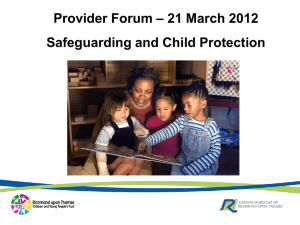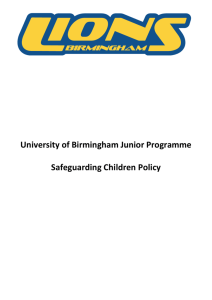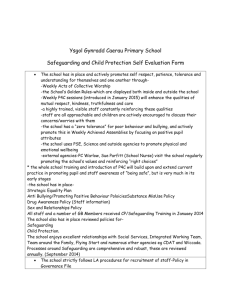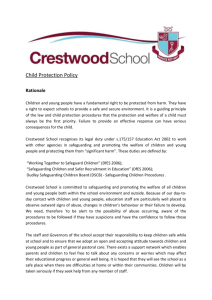Safeguarding policies
advertisement
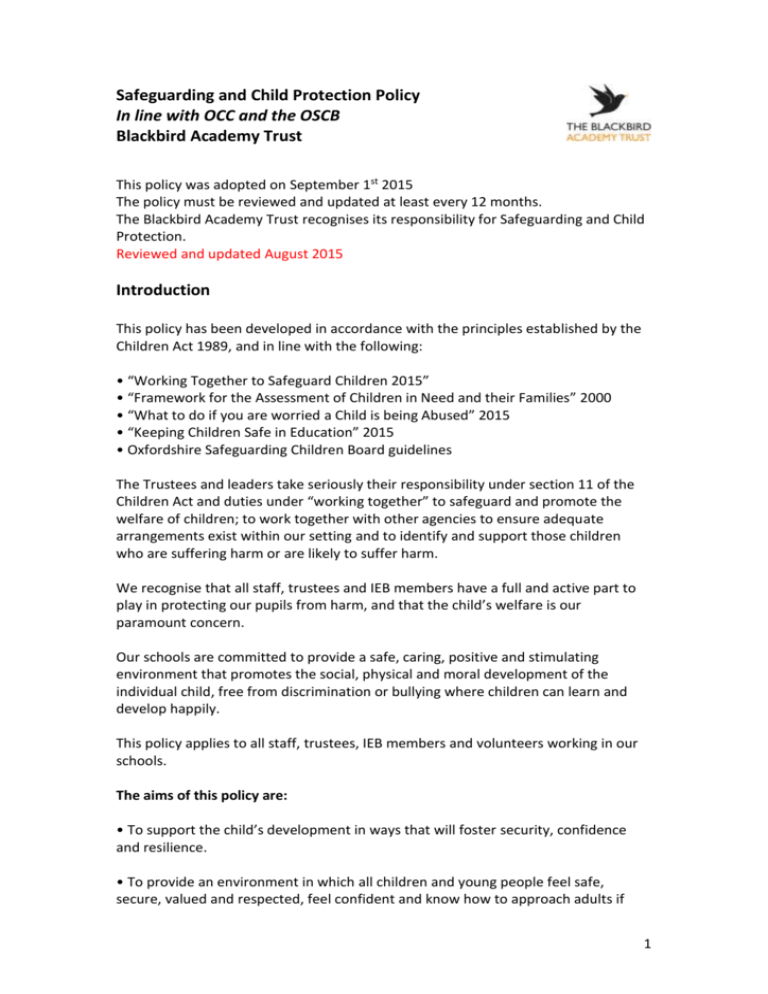
Safeguarding and Child Protection Policy In line with OCC and the OSCB Blackbird Academy Trust This policy was adopted on September 1st 2015 The policy must be reviewed and updated at least every 12 months. The Blackbird Academy Trust recognises its responsibility for Safeguarding and Child Protection. Reviewed and updated August 2015 Introduction This policy has been developed in accordance with the principles established by the Children Act 1989, and in line with the following: • “Working Together to Safeguard Children 2015” • “Framework for the Assessment of Children in Need and their Families” 2000 • “What to do if you are worried a Child is being Abused” 2015 • “Keeping Children Safe in Education” 2015 • Oxfordshire Safeguarding Children Board guidelines The Trustees and leaders take seriously their responsibility under section 11 of the Children Act and duties under “working together” to safeguard and promote the welfare of children; to work together with other agencies to ensure adequate arrangements exist within our setting and to identify and support those children who are suffering harm or are likely to suffer harm. We recognise that all staff, trustees and IEB members have a full and active part to play in protecting our pupils from harm, and that the child’s welfare is our paramount concern. Our schools are committed to provide a safe, caring, positive and stimulating environment that promotes the social, physical and moral development of the individual child, free from discrimination or bullying where children can learn and develop happily. This policy applies to all staff, trustees, IEB members and volunteers working in our schools. The aims of this policy are: • To support the child’s development in ways that will foster security, confidence and resilience. • To provide an environment in which all children and young people feel safe, secure, valued and respected, feel confident and know how to approach adults if 1 they are in difficulties. • To raise the awareness with all staff of the need to safeguard children and of their responsibilities in identifying and reporting possible cases of abuse. • To provide a systematic means of monitoring children known or thought to be at risk of harm, and ensure we contribute to assessments of need and support plans for those children where appropriate. • To acknowledge the need for effective and appropriate communication between all members of staff in relation to safeguarding children and young people. • To develop a structured procedure within the school which will be followed by all members of the staff in cases of suspected abuse. • To develop effective working relationships with all other agencies, involved in safeguarding children. • To ensure that all adults within our schools who have access to children have been checked as to their suitability. This includes other community users of our facilities, following correct staff recruitment and selection procedures. Procedures • Our schools’ procedures for safeguarding children will be in line with Oxfordshire Local Authority (the LA) and Oxfordshire Safeguarding Children Board Child Protection Procedures, and “Working Together to Safeguard Children 2015”. We will ensure that: • The trustees, IEB members and all senior staff understand and fulfil their safeguarding responsibilities. • We have designated members of staff, at least one per school, who have undertaken appropriate training for the role, as recommended by the LA, within the past two years. Our designated staff will update their training with LA/OSCB approved training every two years. Our designated staff members are: Jill Hudson (Executive Head), Kate Geran-Haq (Windale), Francis Murphy (Pegasus) and Stella Cranston (Orchard Meadow). • In the absence of an appropriately trained member of staff, the Headteacher will assume this role. • All adults (including volunteers) new to our school will be made aware of this policy and the procedures for child protection. They will be provided with the name and contact details of the Designated Persons as part of their induction into the school. 2 • All members of staff are provided with opportunities at least every three years to receive training in order to develop their understanding of the signs and indicators of abuse, how to respond to a pupil who discloses abuse and the procedure to be followed in appropriately sharing a concern of possible abuse or a disclosure of abuse. • Our lettings policy will seek to ensure the suitability of adults working with children on our site at any time. • Community users organising activities for children are aware of and understand the need for compliance with the schools’ child protection guidelines and procedures. • The name of any member of staff considered not suitable to work with children will be notified to the DBS (Disclosure and Barring service), with the advice and support of Human Resources and or LADO. • Our procedures will be annually reviewed and up-dated and a summary report of findings sent to our trustees and the local Authority Safeguarding Team/LADO office. Responsibilities Staff in the Blackbird Academy Trust will follow the Oxfordshire Safeguarding Children Board Procedures/Local Authority guidance in all cases of abuse, or suspected abuse (these can be found at www.OSCB.org.uk). We will therefore: • Understand that our responsibility to safeguard children requires that we all appropriately share any concerns that we may have about children. • Ensure that we refer a child if there are concerns about a child’s welfare, possible abuse or neglect to Social Care. A written referral using the Common Referral Form will be faxed/posted/e-mailed to Social Care as soon as possible within 24 hours. • Ensure that detailed and accurate written records of concerns about a child are kept even if there is no need to make an immediate referral. • Ensure that all such records are kept confidentially and securely. • Ensure that the designated staff member, or another appropriate member of staff, attends case conferences, family support meetings, core groups, or other multiagency planning meetings, contributes to the Framework for Assessments process, and provides a report which has been shared with the parents. • Establish and maintain links with relevant agencies and co-operate as required with enquiries of a child protection nature. 3 • Ensure that all school staff are aware of the CP policy and procedures, and understand their responsibilities in being alert to, and acting appropriately in cases of abuse, or suspected abuse, and know how to recognise and refer any concerns. • The designated lead for Child Protection will provide, in every academic year, an annual report detailing any changes to the policy and procedures; training undertaken by the designated person and by all staff, number and type of incidents/cases, and number of children referred to Children’s Social Care and subject to Child Protection Plans (anonymised). This report will fulfil the responsibility to provide the LA with information about their Safeguarding policies and procedures. This should be sent to the LADO/ Safeguarding Team at County Hall no later than the December of the academic year following the academic year to which the report applies. • Keep themselves up to date with knowledge to enable them to fulfil their role, including attending relevant training, at least every two years, provided by the Oxfordshire Safeguarding Children Board, or the Schools Safeguarding Team. Frequent training should include training on child sexual exploitation, radicalisation as well as generalist and specialist safeguarding training. • Ensure that all staff and volunteers understand that there is a procedure to be followed in dealing with child protection allegations made against staff. This procedure must be followed on all occasions. All staff must be made aware of this process and how it differs from other concerns about children. • Ensure that we have staff on all interview panels that are Safer Recruitment Trained. • Ensure that all staff/volunteers are selected and recruited only after having gone through appropriate checks. • All staff and volunteers working in early years or foundation stage (including before and after school provision for under 8’s) will be expected to disclose to the Headteacher or Manager any circumstances which may indicate that the member of staff or volunteer could be barred from working with children under the terms of the Childcare Regulations 2006: • Our setting will have regard to our obligations to prevent our students from being drawn into extremism or terrorism. We recognise that this is our statutory duty under the counter terrorism and security act 2015. Please see the links below for further guidance and information around this. Supporting Children • We recognise that a child who is abused, who witnesses violence or who lives in a violent environment may feel helpless and humiliated, may blame him/herself, and find it difficult to develop and maintain a sense of self-worth. 4 • We understand that research shows that the behaviour of a child in these circumstances may range from that which is perceived to be normal to be aggressive or withdrawn. Our school will support all children and young people by: • Encouraging the development of self-esteem and resilience in every aspect of life. • Promoting a caring, safe and positive environment. • Liaising and working together with all other support services and those agencies involved in the safeguarding of children. • Notifying Social Care as soon as there is a significant concern. • Notifying Social Care when a child/young person attending a school is privately fostered. • Providing continuing support to a pupil (about whom there have been concerns) who leaves the school by ensuring that such concerns and school medical records are forwarded under confidential cover to the Designated Person at the pupil’s new school immediately. Confidentiality • We recognise that all matters relating to child protection are confidential. • The Designated Person will disclose personal information about a child or young person to other members of staff on a need to know basis only. • However, all staff must be aware that they have a professional responsibility to share information with other agencies in order to safeguard children. • All staff must be aware that they cannot promise a child to keep secrets which might compromise the child’s safety or well-being or that of another. • We will always undertake to share our intention to refer a child to Social Care with their parents/carers unless to do so could put the child at greater risk of harm, or impede a criminal investigation. If in doubt, we will consult with the Schools’ Safeguarding Team or Social Care on this point. • We will take ‘no names’ consultations with our local Assessment Teams / MASH team to discuss concerns we may have, but we understand that if they then ask for a name we will disclose those details and it will become a referral. 5 Supporting Staff • We recognise that staff working in the school who have become involved with a child who has suffered harm, or appears to be likely to suffer harm, may find the situation stressful and upsetting. • We will support such staff by providing an opportunity to talk through their anxieties with the Designated Person and to seek further support. This could be provided by another trusted colleague, Occupational Health and/or a representative of a professional body or trade union, as appropriate. • In consultation with all staff, we have adopted a code of conduct for staff at our setting. This forms part of staff induction and is in the staff handbook. We understand that staff should have access to advice on the boundaries of appropriate behaviour. • We recognise that our Designated Person(s) should have access to support and appropriate workshops, courses or meetings as organised by the LA. Allegations against staff • All staff should take care not to place themselves in a vulnerable position with a child. It is always advisable for interviews or work with individual children or parents to be conducted in view of other adults. • We understand that a child or young person may make an allegation against a member of staff. If such an allegation is made, the member of staff receiving the allegation will immediately inform the Head or the most senior member of staff available. • The Head on all such occasions will discuss the content of the allegation with the Designated Officer for the Local Authority (LADO) before taking any action. In our county contact should be made with Barry Armstrong, Designated Officer (01865 815956), Alison Beasley, Safeguarding Coordinator (01865 323457) or Donna Crozier, Safeguarding Coordinator (01865 816382). • If the allegation made to a member of staff concerns the Head themselves, the person receiving the allegation will immediately inform the Chair of the governing body who will consult with LADO, without notifying the manager first. • The school will follow the procedures for managing allegations against staff, as outlined in Keeping Children Safe in Education 2015. • Suspension of the member of staff against whom an allegation has been made needs careful consideration, and we will consult with LADO and HR. 6 • Our lettings agreement for other users requires that the organiser will follow LA procedures for managing allegations against staff and, where necessary, the suspension of adults from premises. Whistleblowing We recognise that children cannot be expected to raise concerns in an environment where staff fail to do so. All staff should be aware of their duty to raise concerns about the attitude or actions of colleagues and appropriate advice will be sought from the LADO or Safeguarding Team where necessary. Physical Intervention/Positive Handling Our policy on physical intervention/positive handling by staff is set out separately, as part of our Relationships/Behaviour Policy. It complies with LA Guidance, ‘The Use of Force to Control or Restrain Pupils’ 2010. Such events should be recorded and signed by a witness. All staff who are likely to need to use physical intervention are appropriately trained. We understand that physical intervention of a nature which is both unreasonable and disproportionate to the circumstances and or causes injury or distress to a child, may be considered under child protection or disciplinary procedures. Anti-Bullying Our policy on the prevention and management of bullying is set out in a separate policy and acknowledges that to allow or condone bullying may lead to consideration under child protection procedures. Bullying is a safeguarding matter that if left unresolved can become a child protection matter. Our setting will take seriously any bullying concerns and will both investigate and take action to protect pupils where appropriate. Health & Safety Our Health & Safety policy, set out in a separate document, reflects the consideration we give to the protection of our children both physically within the school environment and, for example, in relation to internet use, and when away from the school when undertaking school trips and visits. 7 Role of the Trustees and members of the IEB The trustees and members of The Blackbird Academy Trust undertake the regular review of safeguarding related policies and procedures that operate in our schools. The trustees/members of the IEBs have a crucial role in monitoring and challenging staff on the effectiveness of safeguarding arrangements. Role of Staff All staff have a responsibility for action in cases of suspected child abuse. This document outlines the procedures, which should be followed if any member of staff suspects a student is being abused, or if a disclosure is made. All staff are asked to be alert to possible physical or emotional problems being experienced by children and young people. Immediate action is required where there is concern about possible abuse. Written records must be made at each stage of the process. If a student asks to speak to you about a problem do not promise confidentiality but explain that it may be necessary to consult a colleague. Categories of Abuse The table below outlines the four main categories of abuse as defined by the Department of Health ‘Working Together to Safeguard Children’ document 2010. (Full definitions can be found in this document). Staff should be aware that the possible indicators are not definitive and that some children may present these behaviours for reasons other than abuse. Type of Abuse Possible Indicators Neglect The persistent failure to meet a child’s basic physical and psychological needs, likely to result in the serious impairments of the child’s health or development. Neglect may occur during pregnancy as a result of maternal substance abuse. Once a child is born, neglect may involve a parent or carer failing to: provide food, clothing and shelter; protect a child from physical and emotional harm or danger; 8 ensure adequate supervision; ensure access to appropriate medical care or treatment. Obvious signs of lack of care include: Problems with personal hygiene; Constant hunger; Inadequate clothing; Emaciation; Lateness or non-attendance at school; Poor relationship with peers; Untreated medical problems; Compulsive stealing and scavenging; Rocking, hair twisting, thumb sucking; Running away; Low self-esteem. Physical Abuse May involve hitting, shaking, throwing, poisoning, burning or scalding, drowning, suffocating or otherwise causing physical harm to a child. Physical harm may also be caused when a parent or carer fabricates the symptoms of, or deliberately induces illness in a child. Physical signs that do not tally with the given account of occurrence; Conflicting or unrealistic explanations of cause; Repeated injuries; Delay in reporting or seeking medical advice. Sexual Abuse Forcing or enticing a child to take part in sexual activities, not necessarily involving a high level of violence, whether or not the child is aware of what is happening. The activities may involve physical contact, penetrative or non-penetrative acts and also includes involving children in watching pornographic material. Signs may include: Sudden changes in behaviour, displays of affection, which are sexual, and age inappropriate. Tendency to cling or the need of constant reassurance. Tendency to cry easily. Regression to younger behaviour – e.g. thumb sucking, acting like a baby. Unexplained gifts or money. Depression and withdrawal. Watching sexual acts. Wetting/soiling day or night. Fear of undressing for PE Emotional Abuse The persistent emotional maltreatment of a child such as to cause severe and persistent adverse effects on the child’s emotional development. It may involve conveying to children that they are worthless or unloved, inadequate, or valued only insofar as they meet the needs of another person. 9 Rejection. Isolation. Child being blamed for actions of adults. Child being used as carer for younger siblings. Affection and basic emotional care-giving/warmth persistently absent or withheld. Child sexual exploitation (CSE) The sexual exploitation of children and young people under 18 involves exploitative situations, contexts and relationships where young people (or a third person or persons) receive something, (e.g. food, accommodation, drugs, alcohol, cigarettes, affections, gifts, money) as a result of them performing and/or others performing on them, sexual activities. Child sexual exploitation can occur through the use of technology without the child’s immediate recognition; for example being persuaded to post sexual images on the internet/mobile phones without immediate payment or gain. In all cases those exploiting the child/young person have power over them by virtue of their age, gender, intellect, physical strength and/or economic or other resources. Violence, coercion and intimidations are common, involvement in exploitative relationships being characterised in the main by the child’s or young person’s limited availability of choice, resulting from their social/economic and/or emotional vulnerability. Key facts about CSE • Sexual exploitation often starts around the age of 10 years old. Girls are usually targeted from age 10 and boys from age 8. • It affects both girls and boys and can happen in all communities. • Any person can be targeted but there are some particularly vulnerable groups: Looked After Children, Children Leaving Care and Children with Disabilities. • Victims of CSE may also be trafficked (locally, nationally and internationally). • Over 70% of adults involved in prostitution were sexually exploited as children or teenagers. • Sexual violence or abuse against children represents a major public health and social welfare problem within UK society, affecting 16% of children under 16. That is approximately 2 million children. Good practice – Individuals • Recognise the symptoms and distinguish them from other forms of abuse • Treat the child/young person as a victim of abuse 10 • Understand the perspective/behaviour of the child/young person and be patient with them • Help the child/young person to recognise that they are being exploited • Collate as much information as possible • Share information with other agencies and seek advice/refer to Social Care Good practice – Organisations • Ensure robust safeguarding policies and procedures are in place, which cover CSE • Promote and engage in effective multi-agency working to prevent abuse • Work to help victims move out of exploitation • Cooperate to enable successful investigations and prosecutions of perpetrators Forced marriages (FM) FM is now a specific offence under s121 of the Anti-Social Behaviour, Crime and Policing Act 2014 that came into force on 16 June 2014. A FM is a marriage conducted without the valid consent of one or both parties, and where duress is a factor. Forced marriage is when someone faces physical pressure to marry (e.g. threats, physical violence or sexual violence) or emotional and psychological pressure (e.g. if someone is made to feel like they’re bringing shame on their family). This is very different to an arranged marriage where both parties give consent. FM is illegal in England and Wales. This includes: • taking someone overseas to force them to marry (whether or not the forced marriage takes place) • Marrying someone who lacks the mental capacity to consent to the marriage (whether they’re pressured to or not) Female Genital Mutilation (FGM) FGM is child abuse and a form of violence against women and girls, and therefore should be dealt with as part of existing child safeguarding/protection structures, policies and procedures. FGM is illegal in the UK. In England, Wales and Northern Ireland, the practice is illegal under the Female Genital Mutilation Act 2003. Other than in the excepted circumstances, it is an offence for any person (regardless of their nationality or residence status) to: • Perform FGM in England, Wales or Northern Ireland (section 1 of the Act); • Assist a girl to carry out FGM on herself in England, Wales or Northern Ireland (section 2 of the Act); and 11 • Assist (from England, Wales or Northern Ireland) a non-UK person to carry out FGM outside the UK on a UK national or permanent UK resident (section 3 of the Act). Prevent The Counter Terrorism & Security Act 2015 The Act places a Prevent duty on specified schools to have “due regard to the need to prevent people from being drawn into terrorism”. The education and childcare specified authorities in Schedule 6 to the Act are as follows: • The proprietors of maintained schools, non-maintained special schools, maintained nursery schools, independent schools (including academies and free schools) and alternative provision academies, PRUs, registered early years providers, registered late years providers and some holiday schemes. Schools/settings subject to the Prevent Duty will be expected to demonstrate activity in the following areas – • Assessing the risk of children being drawn into terrorism • Demonstrate that they are protecting children and young people from being drawn into terrorism by having robust safeguarding policies. • Ensure that their safeguarding arrangements take into account the policies and procedures of the Local Safeguarding Children Board. • Make sure that staff have training that gives them the knowledge and confidence to identify children at risk of being drawn into terrorism, and to challenge extremist ideas which can be used to legitimise terrorism. • Expected to ensure children are safe from terrorist and extremist material when accessing the internet in school. Dealing with Disclosures Receive Always stop and listen straight away to someone who wants to tell you about incidents or suspicions of abuse. Listen quietly and actively, giving your undivided attention. Allow silences when needed. Do not show shock or disbelief but take what is said seriously. Reassure Stay calm, no judgments, empathise. Never make a promise that you can keep what a child has said a secret. Give reassurance that only those who need to know will be told. Reassure the young person that they were right to tell you. 12 React React to the student only as far as is necessary for you to establish whether or not you need to refer this matter, but don’t interrogate for full details. Don’t ask leading questions – keep the questions open e.g. ’is there anything else you want to say?’ Do not criticize the perpetrator; the student may have affection for him/her. Explain what you will do next – inform designated teacher, keep in contact. Record If possible make brief notes about what they are actually telling you at the time. Keep these notes, however rough they are. If you are unable to make notes at the time write down what was said as soon as you can. Try to record what was actually said by the student rather than your interpretation of what they are telling you. Record the date, time, place and any noticeable non-verbal behaviour. Report Report the incident to the designated teacher and do not tell any other adults or students what you have been told. Record Keeping The designated teachers for child protection are responsible for ensuring that the necessary paperwork is completed and sent to the relevant people and stored in a safe and confidential place. This means that the records will be a coherent factual record of the concerns that are stored on individual children in a clear chronological order. Never attempt to carry out an investigation of suspected abuse by interviewing the young person or any others involved. This is a highly skilled role and any attempts by you could affect possible criminal proceedings. 13




